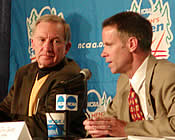It seemed fitting that on the same day the largest crowd in history witnesses an NCAA ice hockey tournament game, NCAA President Cedric Dempsey all but guaranteed the tournament field will expand next year from 12 to 16 teams. It will be the first expansion of the tournament since 1988.
“The [NCAA] Management Council will be voting this week on expansion and from all indications I have, that will probably pass,” said Dempsey during a news conference Thursday.

Expansion was given high hopes by the men’s ice hockey committee two months ago, when the Championship Cabinet approved the increase in field size for the second time in three years. This year, unlike its first approval in 2000, the Cabinet earmarked funds for expansion of men’s hockey along with men’s lacrosse, men’s soccer and softball. That makes it the top priority for sports to expand when the Management Council votes this week.
The Management Council is the second, but most important, of three ratifications that any legislation, including expansion, must pass within the NCAA. Once passed by the Council, legislation is given final approval by the Board of Directors, but according to Dempsey, when it comes to bracket expansion, that is essentially a rubberstamp once the Council gives its approval.
“We have had tremendous growth in our championship programs in the last four years now,” said Dempsey. “Ice hockey is an example of that. We have more than 40,000 championship opportunities for student-athletes in this country through our 87 national sports. That’s a growth in a four-year period from 20,000. That’s where a lot of our dollars go.”
Once approved, the next step will be determining additional regional venues. Two years ago, the NCAA awarded East and West Regional sites through 2006. According to NCAA Director of Championships Tom Jacobs, these sites will remain, with one added in each of the East and West.
“The timetable that the committee has in process for selecting those additional sites will be immediately following the Board of Directors meeting at the end of the April so that bids can be solicited during the month of May,” said Jacobs. “The committee conducts its annual meeting June 4-7. That is when they’ll review the bids and make recommendations to the championship cabinet in September for sites from 2003 through 2006.
“The committee is really excited because now you’ll be able to crown a regional champion. Basically, they’ll play four, four-team championships at each regional site.”
Jacobs says the suggested names for the regions will be East, Northeast, Central and West. He also noted that the two geographically East and West regions would not play on the same day. Thus, if the sites are within driving distance from one another, fans would be able to attend both regional tournaments.
Also addressed was the “regionalization” of the tournament field. For the first time since adopting the regional format in 1992, all six teams in each region were geographically located in that area. According to Jacobs, this will be reviewed by the NCAA before next fall.
“The Cabinet implemented the [regionalization] policies for the fall sports only to lessen the air travel by participants [in the wake of Sept. 11],” said Jacobs. “They then reviewed the policies again in February and decided those policies should continue for the winter and spring championships.
“The Cabinet will meet again and June and September to review what they put in place this year and see if they should continue for the next academic year.”
Dempsey, though, noted that this year’s format produced record crowds during the regional tournament which might be considered a strong reason to keep things the same.
“While this was a decision for this year only, there were some by-products of that each committee will be looking at,” said Dempsey. In addition to excellent attendances, other byproducts included less class time missed by the student athletes and the ability to play closer to family and the fan base.
Dempsey also discussed the NCAA’s amplified contract with both CBS and ESPN, the end result of which will be an extreme increase in exposure of collegiate athletics.
“The CBS contract jumps 30 percent this year and then will grow at the rate of eight percent per year for the next ten years,” said Dempsey. “ESPN has a commitment to having fuller coverage [the men’s hockey] championship as well as other championships. We don’t want to have just championship week coverage of our championships but also a year-round presence on ESPN and CBS.”
Dempsey also referenced the maintenance of amateur status for college hockey players. The standards have been relaxed in recent years, something that Dempsey believes will continue.
“When we began the study on amateurism four years ago, ice hockey was one of the first groups our staff met with,” said Dempsey.
He noted that in this week’s meeting of the NCAA Management Council, legislation regarding amateur status will be discussed. Specifically, the Council will consider a move to allow players to receive compensation for sport-related expenses incurred before entering college.
Currently, any student who receives compensation prior to attending college is unable to play Division I collegiate athletics. Legislation would allow players to receive compensation for, in the case of hockey for example, equipment, membership fees associated with playing junior hockey, and ice time fees.
This year’s NCAA tournament is expected to turn a profit of $1 million for the first time. Men’s hockey was one of only four sports — including men’s basketball, men’s wrestling and men’s baseball — that generated a profit during the 2000-01 academic year.


